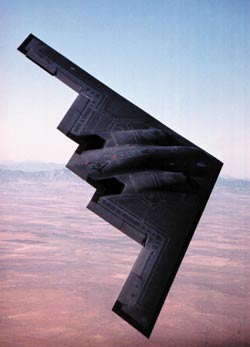CIAO DATE: 03/01

Foreign Policy
A Matter of Precision
Phillip S. Meilinger
Why air power may be more humane than sanctions

During the last century, air attacks on civilian noncombatants, whether intentional or accidental, have produced some of war's most shocking images. Yet public revulsion over the toll that air war can take on civilians belies an emerging truth: Not only have air strikes accounted for a tiny proportion of civilian wartime deaths, but recent technological advances in weaponry and intelligence have significantly reduced casualties among both attackers and attacked. Indeed, in comparison with the devastating impact on civilians of coercive mechanisms such as sanctions, modern air warfare stands out as an increasingly efficient, effective, and humane tool of foreign policy.
Although well over 100 million people died in wars during the 20th century (the vast majority of whom were noncombatants), relatively few were victims of bombing attacks. According to one estimate, 62 million perished from 1900 to 1970 as a result of genocide or war-induced starvation; 24 million were killed by small arms; 17 million by artillery and naval gunfire; and 2 million due to air attack.
Over the last decade, the growing sophistication of air warfare has dramatically diminished the likelihood of noncombatant deaths. Consider the results of NATO's air campaign over Kosovo: While Human Rights Watch estimates that there were 90 instances during Operation Allied Force when attacking NATO aircraft caused civilian casualties and collateral damage, that number is low considering the number of strikes flown (14,000) and munitions dropped (28,000). In one case, aircrews were given the wrong target–the Chinese embassy. In another, a guidance system failed and the bomb landed in a residential area. On another occasion, an aircraft attacked a bridge just as a passenger train unexpectedly passed over it. And in a tragic misidentification, NATO pilots killed several dozen refugees in an attack on a column of vehicles. While any loss of civilian life is deplorable, the relatively few noncombatants killed by bombing attacks–Human Rights Watch estimates 500–is nonetheless remarkable for such an intense air campaign.
A number of revolutionary technologies have helped make this self-imposed restraint possible. Guided by cameras, lasers, or satellites, today's air-launched precision guided munitions (PGMs) use adjustable fins to home in on their targets. Perfect accuracy is not guaranteed–failure of the guidance system or aircraft equipment and errors by aircrews mean that accidents still happen–but current PGMs have an accuracy that is usually measured in feet. The speed, reach, and power of current information technology, in turn, enable rapid targeting and deployment. Over Kosovo, for example, a U-2 aircraft took video images of a suspected target and sent them by satellite to the United States. These images were fused with three-dimensional terrain data and satellite imagery to produce precise geographical coordinates, which were then relayed to orbiting command-and-control aircraft that directed airborne fighter-bombers to the target. The entire process took place in minutes.
The almost total reliance of NATO on air power during the Kosovo campaign drew widespread criticism. Some observers argued that NATO's refusal to commit ground troops and its decision to protect its pilots by flying bombing sorties at altitudes above 15,000 feet undermined the morality of the alliance's actions. (Presumably, these critics would have rested easier if more of the nearly 700 surface-to-air missiles and tens of thousands of antiaircraft shells fired by Milosevic's forces had found targets.) But in the vast majority of cases, the decision to fly at a higher altitude did not endanger civilians by adversely affecting bomb accuracy. In fact, precision bombs are most accurate when dropped from an altitude of 15,000 to 23,000 feet, a height that enables the weapon to correct itself in-flight.
While few civilized humans would argue against the drive to limit the suffering of noncombatants, the call for greater discrimination, accuracy, and restraint in air attacks rings false when set beside the death and destruction caused by more traditional forms of coercion. Never mind the carnage of recent sieges, such as those of Sarajevo and Grozny, or the potential toll on civilians had there been a ground war in Kosovo. Consider the recent impact of seemingly nonviolent weapons such as sanctions and embargoes. In Haiti, the sanctions imposed by the Organization of American States (in 1991) and the United Nations (in 1993) not only failed to persuade coup leaders to surrender power but caused considerable civilian deaths. One 1993 study by the Harvard Center for Population and Development Studies found that the sanctions killed 1,000 children per month–a particularly disturbing number when contrasted with the handful of deaths, military and civilian, resulting from the armed intervention the United States was so reluctant to launch.
Some argue that this kind of suffering is the responsibility of rogue regimes that refuse to give up. But history demonstrates that those under embargo generally accept casualties as the price necessary to achieve their objectives. A wealth of empirical data shows that blockades, embargoes, sanctions, and sieges almost always have a percolating effect: They start killing at the bottom levels of society and work their way up. It is not the dictators and their cronies who go to bed without their supper. Most recently, U.N. studies of the impact of sanctions against Iraq suggest that a half million infants died between 1991 and 1998 as a result of the continuing U.N. embargo. When this staggering number is juxtaposed with the total of 2,300 civilians that Iraq claims were killed during the six-week air campaign in 1991, a glaring disconnect emerges between public endorsement of "humane" coercion and public demands for greater discrimination in air warfare.
If a military operation had caused such enormous death and suffering, it would have immediately and irrevocably lost the moral high ground. Instead, the U.S. public standard for military action now seems to resemble the ethic that prevailed on old TV Westerns: The good guy–the one in the white hat–never killed the bad guy. He shot the gun out of his hand and arrested him. Modern air power may not solve every military problem, but thanks to the innovations of the last decade, it is the weapon in the U.S. arsenal that comes closest to fulfilling that goal.
Phillip S. Meilinger is a former U.S. military pilot and deputy director of the AEROSPACENTER at Science Applications International Corporation.